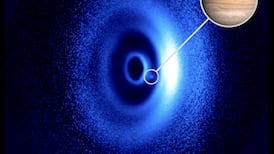Japan on Friday became the fifth country to put a spacecraft on the moon but the lander was not generating solar power, its space agency said, during a mission to prove a “precision” landing technology and revitalise a space programme that has suffered setbacks.
The Japan Aerospace Exploration Agency (Jaxa) said its Smart Lander for Investigating Moon (Slim) landed on the moon’s surface at about 12.20am on Saturday (3.20pm on Friday Irish time) and re-established communication with Earth, but its solar panels were not able to generate electricity, possibly because they are angled wrong.
“Slim is now operating only on its battery, and we are prioritising the transfer of its data on to Earth,” Hitoshi Kuninaka, the head of Jaxa’s research centre, told a press conference.
Despite “life-sustaining treatments” such as turning off its heater, Slim’s battery lasts only for “a few hours”, so Jaxa said it would maintain the status quo rather than take risky actions.
READ MORE
Jaxa hopes a shift in the sunlight’s angle will hit the panels in a way that can restore its functions, Mr Kuninaka said.
“It takes 30 days for the solar angle to change on the moon,” Mr Kuninaka said. “So when the solar direction changes, and the light shines from a different direction, the light could end up hitting the solar cell.”
Dubbed the “moon sniper”, Slim attempted to land within 100m of its target, versus the conventional accuracy of several kilometres, a technology Jaxa says will become a powerful tool in future exploration of hilly moon poles seen as a potential source of oxygen, fuel and water.
“Looking at the trace data, Slim most certainly achieved a landing with 100-metre accuracy,” Mr Kuninaka said, although he added that it would take about a month to verify it.
Japan is increasingly looking to play a bigger role in space, partnering with ally the United States to counter China. Japan is also home to several private-sector space start-ups and Jaxa aims to send an astronaut to the moon as part of Nasa’s Artemis programme in the next few years.
But the Japanese space agency has recently faced multiple setbacks in rocket development, including the launch failure in March of its new flagship rocket H3 that was meant to match cost-competitiveness against commercial rocket providers such as SpaceX.
The failure caused widespread delays in Japan’s space missions, including Slim and a joint lunar exploration with India, which in August made a historic touchdown on the moon’s south pole with its Chandrayaan-3 spacecraft. – Reuters













